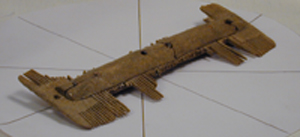








The spoon is partly finished, made from cattle bone,would have been used for cooking and at mealtimes.
Both items found in the Milton Keynes area circa 6th/8th century
 |
|
 |
||||||||||||||
| Saxons and Vikings- From the death of Alfred the Great in 899 to the death of Ethelred in 1016, England was frequently at war with Viking invaders from Scandanavia. In 1002 King Ethelred ordered the Massacre of St Brices Day, which gave orders to slay all the Danes in England. This included the Danish settlers in Castlethorpe, Haversham , Newport Pagnell, Simpson , Lathbury, Olney, Woolstone and Ravenstone. The Danes responded in 1010 with bloody revenge, plundering and burning the whole of East Anglia. When Ethelred died in 1016 there were two claimants to the throne. The Danes chose Canute, Son of Sweyn and the English chose Ethelreds son Edmund. Pursuing their claims, Canute and Edmund fought several battles until after a tremendous struggle in October 1016, they agreed to divide the country between them. However, Edmund died soon afterwards and Canute became King, with England soon to become part of a vast Scandanavian empire. After Canutes death in 1035 the throne passed to his sons and then in 1042, to Edward The Confessor, who reigned until 1066 | ||||||||||||||||
 |
 |
 |
||||||||||||||
|
|
||||||||||||||||
| In 1967 seven Saxon burials were discoverd during gravel quarrying.In 1992 the remains of a further sixty-seven people were found in relatively shallow graves whilst excavating prior to extending the village Community Centre carpark. No grave goods were found, although pottery finds suggested the graves dated between the ninth and twelfth centuries -spanning the Norman Conquest. | ||||||||||||||||
 |
||||||||||||||||
| This photograph shows one of the skeletons unearthed in1992. All of the remains were reburied in All Saints' Churchyard in keeping with their beliefs.A plaque was placed over the reburial site. | ||||||||||||||||
 |
||||||||||||||||
 |
 |
This photograph shows a womans bone comb with riveted handle with hanging hole, made by family members skills possible handed down from parent to child.
The spoon is partly finished, made from cattle bone,would have been used for cooking and at mealtimes. Both items found in the Milton Keynes area circa 6th/8th century |
||||||||||||||
|
|
||||||||||||||||